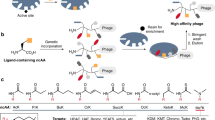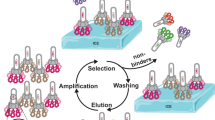Abstract
We have developed a versatile phagemid system to display peptides on the surface of M13 bacteriophage at a copy number which approaches monovalency. In this system, a phagemid encodes a peptide fused to the ammo-terminus of the second domain (dII) of the minor coat protein pIII under control of the inducible lac promoter. The fusion protein is displayed in combination with several copies of wild-type pIII on the surface of phage. Two diverse random octapeptide libraries, one linear and one which contained flanking cysteines capable of forming disulflde bridges, were were generated using an in vitro mutagenesis approach and affinity selected on an anti-somatostatin mAb. Peptides with high affinity for the mAb were enriched only from the cyclic library and the tetrapeptide, FWKT, was identified by consensus as the binding epitope. The selected peptides exhibited not only the primary amino acid sequence but also shared structural features with somatostatin. One peptide, CRFWKTWC, also exhibited nanomolar affinities for the five known somatostatin receptor subtypes. This system can easily be adapted to display individual peptides or a wide range of custom peptide libraries.
This is a preview of subscription content, access via your institution
Access options
Subscribe to this journal
Receive 12 print issues and online access
$209.00 per year
only $17.42 per issue
Buy this article
- Purchase on Springer Link
- Instant access to full article PDF
Prices may be subject to local taxes which are calculated during checkout
Similar content being viewed by others
References
Geysen, H.M., Meloen, R.H. and Barteling, S.J. 1984. Use of a peptide synthesis to probe viral antigens for epitopes to a resolution of a single amino acid. Proc. Natl. Acad. Sci. USA 81: 3998–4002.
Houghten, R.A., Appel, J.R., Blondelle, S.E., Cuervo, J.H., Dooley, C.T. and Pinilla, C. 1992. The use of synthetic peptide combinatorial libraries for the identification of bioactive peptides. BioTechniques 13: 412–421.
Christian, R.B., Zuckerman, R.N., Kerr, J.M., Wang, L. and Malcolm, B. 1992. Simplified methods for construction, assessment and rapid screening of peptide libraries in bacteriophage. J. Mol. Biol. 227: 711–718.
Cwirla, S.E., Peters, E.A., Barrett, R.W. and Dower, W.J. 1990. Peptides on phage: A vast library of peptides for identifying ligands. Proc. Natl. Acad. Sci. USA 87: 6378–6382.
Devlin, J.J., Panganiban, L.C. and Devlin, P.E. 1990. Random peptide libraries: A source of specific protein binding molecules. Science 249: 404–406.
Parmley, S.F. and Smith, G.P. 1988. Antibody-selectable filamentous fd phage vectors: affinity purification of target genes. Gene 73: 305–318.
Cull, M.G., Miller, J.F. and Schatz, P.J. 1992. Screening for receptor ligands using large libraries of peptides linked to the C terminus of the lac represser. Proc. Natl. Acad. Sci. USA 89: 1865–1869.
Felici, F., Castagnoli, L., Musacchio, A., Jappelli, R. and Cesareni, G. 1991. Selection of antibody ligands from a large library of oligopeptides expressed on a multivalent exposition vector. J. Mol. Biol. 222: 301–310.
Scott, J.K. and Smith, G.P. 1990. Searching for peptide ligands with an epitope library. Science 249: 386–390.
Stephen, C.W. and Lane, D.P. 1992. Mutant conformation of p53: Precise epitope mapping using a filamentous phage epitope library. J. Mol. Biol. 225: 577–583.
Matthews, D.J. and Wells, J.A. 1993. Substrate phage: Selection of protease substrates by monovalent phage display. Science 260: 1113–1117.
Oldenburg, K.R., Loganathan, D., Goldstein, I.J., Schultz, P.G. and Gallop, M.A. 1992. Peptide ligands for a sugar-binding protein isolated from a random peptide library. Proc. Natl. Acad. Sci. USA 89: 5393–5397.
O'Neil, K.T., Hoess, R.H., Jackson, S.A., Ramachandran, N.S., Mousa, S.A. and DeGrado, W.F. 1992. Identification of novel peptide antagonists for gpIIb/IIIa from a conformationally constrained phage peptide library. Prot. Struct. Funct. Genet. 14: 509–515.
Scott, J.K., Loganathan, D., Easley, R.B., Gong, X. and Goldstein, I.J. 1992. A family of concanavalin A-binding peptides from a hexapeptide epitope library. Proc. Natl. Acad. Sci. USA 89: 5398–5402.
Lawman, H.B., Bass, S.H., Simpson, N. and Wells, J.A. 1991. Selecting high-affinity binding proteins by monovalent phage display. Biochem. 30: 10832–10838.
Swimmer, C., Lehar, S.M., McCaflerty, I, Chiswell, D.J., Blattler, W.A and Guild, B.C. 1992. Phage display of ricin B chain and its single binding domains: System for screening galactose-binding mutants. Proc. Natl. Acad. Sci. USA 89: 3756–3760.
Garrard, L.J., Yang, M., O'Connell, M.P., Kelley, R.F. and Henner, D.J. 1991. Fab assembly and enrichment in a monovalent phage display system. Bio/Technology 9: 1373–1377.
Bass, S., Greene, R. and Wfells, J.A. 1990. Hormone phage: An enrichment method for variant proteins with altered binding properties. Prot. Struct. Funct. Genet. 8: 309–314.
Kunkel, T.A., Roberts, J.D. and Zakour, R.A. 1987. Rapid and efficient site-specific mutagenesis without phenotypic selection. Meth. Enzymol. 154: 367–382.
Barbas, C.F., III, Kang, A.S. and Benkovic, R.A.L.S.J. 1991. Assembly of combinatorial antibody libraries on phage surfaces: The gene III site. Proc. Natl. Acad. Sci. USA 88: 7987–7982.
Gram, H., Strittmatter, U., Lorenz, M., Glueck,D. and Zenke,G. 1993. Phage display as a rapid gene expression system: production of bioactive cytokine-phage and generation of neutralizing monoclonal antibodies. J. Immunol. Methods. 161: 169–176.
Van Binst, G. and Tourwe, D. 1992. Backbone modifications in somatostatin analogues: relation between conformation and activity. Peptide Res. 5: 8–13.
Delaet, N.G.J., Verheyden, P., Velkeniers, B., Hooghe-Peters, E.L., Bruns, C., Tourwe, D. and Van Binst, G. 1993. Synthesis, biological activity and conformational study of a somatostatin hexapeptide analogue containing a reduced peptide bond. Peptide Res. 6: 24–30.
Gurrath, M., Muller, G., Kessler, H., Aumailley, M. and Timpl, R. 1992. Conformational/activity studies of rationally designed potent anti-adhesive RGD peptides. Eur. J. Biochem. 210: 911–921.
Barrett, R.W., Cwirla, S.E., Ackerman, M.S., Olson, A.M., Peters, E.A. and Dower, W.J. 1992. Selective enrichment and characterization of high affinity ligands from collections of random peptides on filamentous phage. Analytical Biochem. 204: 357–364.
Author information
Authors and Affiliations
Rights and permissions
About this article
Cite this article
Wright, R., Gram, H., Vattay, A. et al. Binding Epitope of Somatostatin Defined by Phage-Displayed Peptide Libraries. Nat Biotechnol 13, 165–169 (1995). https://doi.org/10.1038/nbt0295-165
Received:
Accepted:
Issue Date:
DOI: https://doi.org/10.1038/nbt0295-165
This article is cited by
-
Somatostatin displayed on filamentous phage as a receptor‐specific agonist
British Journal of Pharmacology (1998)



